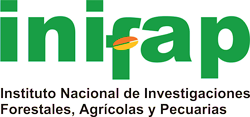Climate change and potential distribution of lima beans in Mesoamérica and Aridoamérica
DOI:
https://doi.org/10.29312/remexca.v11i6.2412Keywords:
adaptation, climate change, ecological descriptors, lima beansAbstract
The objectives of this investigation were to characterize the ecological descriptors and to evaluate the impacts of climate change on the potential distribution of the lima bean Phaseolus lunatus L. in the Mesoamerica and Aridoamerica regions. A database of sites of occurrence was integrated taking six sources. From the geographical coordinates of these sites of occurrence and by using geographic information systems, values of agroclimatic variables derived from rasters of the Worldclim, USGS/NASA SRTM and CGIAR systems were extracted. Thus, an agroclimatic data matrix was integrated through which the ecological descriptors of Phaseolus lunatus were determined. The distribution of P. lunatus was modeled with the Maxent model. The results showed that P. lunatus adapts to a wide range of environmental conditions that includes a hydric condition that goes from semi-arid to humid, a thermal condition that ranges from tempered to very warm, and has a presence in the altitudinal, thermal and rain ranges of 0-2 386 masl, 13.2-29.9 °C and 400-4 250 mm, respectively. These descriptors indicate the existence of populations carrying genes resistant to climatic stress conditions. The Maxent model successfully modeled the distribution of Phaseolus lunatus in the different climatic scenarios evaluated (AUC= 0.94). The climate change projected by the HADGEM-ES model for 2050 and 2070 and RCPs 4.5 and 8.5 is unfavorable for the distribution of P. lunatus, while according to the CCMS4 model the climate 2050 and 2070 is favorable on the RCP4.5 route and unfavorable on route RCP8.5.
Downloads
Published
How to Cite
Issue
Section
License
Copyright (c) 2020 Revista Mexicana de Ciencias Agrícolas

This work is licensed under a Creative Commons Attribution-NonCommercial 4.0 International License.
The authors who publish in Revista Mexicana de Ciencias Agrícolas accept the following conditions:
In accordance with copyright laws, Revista Mexicana de Ciencias Agrícolas recognizes and respects the authors’ moral right and ownership of property rights which will be transferred to the journal for dissemination in open access. Invariably, all the authors have to sign a letter of transfer of property rights and of originality of the article to Instituto Nacional de Investigaciones Forestales, Agrícolas y Pecuarias (INIFAP) [National Institute of Forestry, Agricultural and Livestock Research]. The author(s) must pay a fee for the reception of articles before proceeding to editorial review.
All the texts published by Revista Mexicana de Ciencias Agrícolas —with no exception— are distributed under a Creative Commons License Attribution-NonCommercial 4.0 International (CC BY-NC 4.0), which allows third parties to use the publication as long as the work’s authorship and its first publication in this journal are mentioned.
The author(s) can enter into independent and additional contractual agreements for the nonexclusive distribution of the version of the article published in Revista Mexicana de Ciencias Agrícolas (for example include it into an institutional repository or publish it in a book) as long as it is clearly and explicitly indicated that the work was published for the first time in Revista Mexicana de Ciencias Agrícolas.
For all the above, the authors shall send the Letter-transfer of Property Rights for the first publication duly filled in and signed by the author(s). This form must be sent as a PDF file to: revista_atm@yahoo.com.mx; cienciasagricola@inifap.gob.mx; remexca2017@gmail.
This work is licensed under a Creative Commons Attribution-Noncommercial 4.0 International license.



